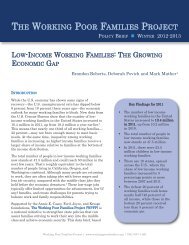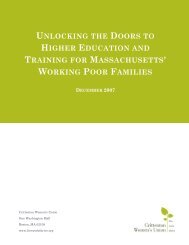alabama's working families and the broken promise of economic ...
alabama's working families and the broken promise of economic ...
alabama's working families and the broken promise of economic ...
- No tags were found...
Create successful ePaper yourself
Turn your PDF publications into a flip-book with our unique Google optimized e-Paper software.
Almost half a million <strong>of</strong> Alabama’s <strong>working</strong>-ageadults lack ei<strong>the</strong>r a high school degreeor a general equivalency diploma.high school degree or a general equivalency diploma.18 Almost half <strong>of</strong> all Alabamians aged 25 to 54, <strong>the</strong>prime <strong>working</strong> years, have a high school diploma orless, <strong>and</strong> only one-third <strong>of</strong> our citizens in that agerange have an associate’s degree or higher. 19Among young adults aged 18 to 24, only 32 percentare enrolled in postsecondary education; <strong>the</strong>continuing racial gap is evident in <strong>the</strong> fact thatonly 23 percent <strong>of</strong> African Americans in that agerange are students in postsecondary institutions.Only 5.8 percent <strong>of</strong> adults aged 25-54 are enrolledin traditional postsecondary programs. In <strong>the</strong>seindicators, <strong>and</strong> every o<strong>the</strong>r one related to educationalattainment <strong>and</strong> access, Alabama comesin below <strong>the</strong> national average, usually among <strong>the</strong>lowest-ranked states. By any measure, <strong>the</strong>re isample room for improvement <strong>and</strong> expansion <strong>of</strong>workforce education. Substantial evidence suggeststhat comprehensive campaigns to engageadult learners in educational programs pay <strong>of</strong>f.Kentucky’s “Go Higher” campaign resulted in adoubling <strong>of</strong> participation in adult education programsin only five years, from fewer than 52,000 participantsin 2000 to more than 124,000 in 2005. 20The correlation between educational attainment<strong>and</strong> earnings is well documented. A 2004 analysisby <strong>the</strong> Minnesota Population Center findsthat average earnings for an Alabamian without ahigh school degree are only half <strong>of</strong> what an Alabamaresident with a bachelor’s degree earns. 21 Atone time, Alabama’s leading industries – agriculture,mining, steelmaking, textiles – relied moreheavily on workers’ brawn than on <strong>the</strong>ir brains. In<strong>the</strong> older economy, a host <strong>of</strong> factors – includingdeficient education <strong>and</strong> earning power, oppressivesocial structures, <strong>and</strong> <strong>the</strong> traditional values<strong>of</strong> self-reliance <strong>and</strong> independence – kept manyAlabamians culturally <strong>and</strong> <strong>economic</strong>ally isolatedfrom <strong>the</strong> nation at large. The changing dem<strong>and</strong>s<strong>of</strong> a high-tech, consumer economy are making itincreasingly difficult to get by without “connecting”to <strong>the</strong> outside world through education <strong>and</strong>training. In keeping with <strong>the</strong> best legacy <strong>of</strong> <strong>the</strong>irpast, Alabamians must recognize that <strong>the</strong> roadto <strong>economic</strong> self-sufficiency today crosses newterrain. Until voters <strong>and</strong> policymakers support programsthat bridge <strong>the</strong> knowledge <strong>and</strong> skills gap,that road will remain impassable for many <strong>of</strong> <strong>the</strong>state’s low-income workers.As more traditional industries have declinedor relocated overseas, <strong>the</strong> state has focused itsefforts on recruiting industries that require a moresophisticated skills set <strong>and</strong> higher general levels<strong>of</strong> education. The state has begun to realize <strong>the</strong>importance <strong>of</strong> investing in elementary <strong>and</strong> secondaryeducational systems so tomorrow’s workers willbe prepared for <strong>the</strong> jobs <strong>the</strong> future holds. If Alabamawishes to continue its successes in <strong>economic</strong>development, it must recognize that providing <strong>the</strong>necessary training <strong>and</strong> skills to those already in <strong>the</strong>workforce is equally important.Alabama links low-income adults to training <strong>and</strong>educational opportunities through four primarysystems:• The Alabama College System, consisting <strong>of</strong> publictwo-year community <strong>and</strong> technical colleges <strong>and</strong> anupper-division college, under <strong>the</strong> authority <strong>of</strong> <strong>the</strong>State Board <strong>of</strong> Education.• Adult Basic Education, <strong>of</strong>fered through <strong>the</strong> AlabamaCollege System.• The Office <strong>of</strong> Workforce Development (OWD)<strong>of</strong> <strong>the</strong> Alabama Department <strong>of</strong> Economic <strong>and</strong>Community Affairs (ADECA).• The Temporary Assistance to Needy Families(TANF) program, administered by <strong>the</strong> AlabamaDepartment <strong>of</strong> Human Resources.The Alabama College SystemThe Alabama College System consists <strong>of</strong> 21 comprehensivecommunity colleges <strong>and</strong> four technicalcolleges, in addition to extensive workforce developmentinitiatives. During <strong>the</strong> 2005-06 academicyear, almost 129,000 students were enrolled in collegecredit courses, <strong>and</strong> ano<strong>the</strong>r 64,000 studentswere in non-credit programs <strong>and</strong> courses. The systemserves primarily Alabama students, with 9518 Bridging <strong>the</strong> Gap







